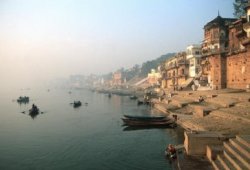GANGES

The Ganges (Gaïgà) is the longest river in India and flows through the Middle Land, that part of India where the Buddha lived. The river's great size and beauty, and its ability to both nourish crops and to sweep away villages when in flood, meant that it was looked upon with a mixture of reverence and awe. A character in the Jàtaka says: `I revere the Ganges whose waters flow and spread'(J.V,93). The ancient commentaries give a completely fantastic description of the river's source and first reaches, saying that it starts from Lake Anotatta, rises up into the air and then passes through several rock tunnels before flowing into India. The Tipiñaka says nothing about the source of the Ganges other than that it starts somewhere in the Himalayas. The Jatàkas often mentions that when the Bodhisattva was an ascetic in his former lives, he went into the Himalayas and `made a hermitage near a bend in the Ganges'(e.g. Ja.II,145; II,258). The upper reaches of the Ganges were called Uddhagaïgà (Ja.II,283), the Yamunà joins it at Payàga (modern Allahabad, Ja.II,151) and the river eventually flows into the sea (A.IV,198-9). Indians have long believed that the Ganges' waters wash away the effects of any evil they have done, a belief which the Buddha disparaged (M.I,39).
The Buddha often used the Ganges as a simile or metaphor in his teachings (e.g. M.I,225; S.II,184; IV,298). When he wanted to give the idea of an incalculable amount of something he would say that it was as numerous as the grains of sand in the Ganges (S.IV,376). When he wanted to emphasize the effectiveness of his teachings for attaining nirvana he used the inevitable, unstoppable eastward flow of the Ganges to illustrate this idea. `Just as the Ganges flows, slides, tends towards the east, so too, one who cultivates and makes much of the Noble Eightfold Path flows, slides tends towards nirvana'(S.V,40).
When the Buddha left Pàñaliputta (now Patna) during his last journey, he had to cross the Ganges in order to get to Vesàli. Today the river at this point is nearly a kilometer wide and it was probably just as wide in ancient times. The townspeople who had come to bid him farewell walked up and down the river bank looking for a ferry or a boat to use to cross the river. Some even began binding reeds together in an attempt to make rafts. Then, according to the Mahàparinibbàna Sutta, `as quickly as a strong man might stretch out his arm and draw it back again, the Buddha and his monks vanished from this bank and reappeared on the other bank of the river'(D.II,89).
Those who believe Buddhism had some influence on Christianity often cite this incident as being a parallel to the story about Jesus walking on the water (Mark 6, 45-52). The comparison is, however, a tenuous one. Whoever wrote the story about Jesus walking on the water believed it to be literally true and presented it as proof of Jesus' divinity. Many Christians still accept it as such. The story about the Buddha crossing the Ganges does not have him walking on the water but disappearing from one location and reappearing in another. In the Christian story, Jesus walks on the water while his disciples look on in amazement, emphasizing the former's divinity and the latter's limited humanity. In the Buddhist story, both the Buddha and his disciples disappear and reappear, suggesting their spiritual equality as far as psychic powers are concerned.
But more importantly, the Buddhist story is not meant to be taken literally, although some people may well have done so. It is an example of a didactic embellishment, a tale meant to catch and hold the attention and then make an important point, a literary device often used in the Pàëi Tipiñaka and other Indian literature. The point of this story is to emphasize the majesty of the enlightened person, whether the Buddha's or arahats. At the end of the incident the Buddha looks back across the river, sees the people still running up and down along the opposite bank and says: `When they want to cross the ocean, a lake or an expanse of water, people make a bridge or raft. But the wise ones have already crossed over'(D.II,89). See Buddha and Jesus and Miracles.